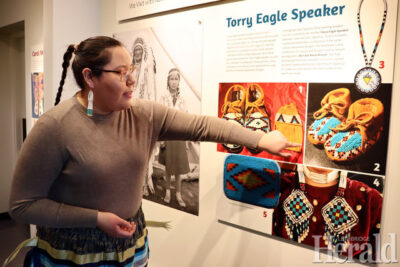New Indigenous exhibits open at the Galt Museum
By Al Beeber - Lethbridge Herald on February 10, 2022.
 Herald photo by Al Beeber
Kalli Eagle Speaker, Indigenous engagement assistant the Galt museum, looks at part of an exhibit she helped organize featuring Kainai beadwork.
Herald photo by Al Beeber
Kalli Eagle Speaker, Indigenous engagement assistant the Galt museum, looks at part of an exhibit she helped organize featuring Kainai beadwork.LETHBRIDGE HERALDabeeber@lethbridgeherald.com
The first of three Indigenous art exhibits, curated by or co-organized with Indigenous experts, has opened at the Galt Museum.
Breathe (2nd Wave), a touring exhibit of traditionally crafted masks by Indigenous and non-Indigenous artists reflecting resiliency through the COVID-19 pandemic, opened Jan. 29 and runs through April 29.
Co-created by Metis artists Nathalie Bertin and Lisa Shepherd, the exhibit is a grassroots initiative that explores the experiences of artists while navigating changing COVID-19 conditions.
It features 44 masks encompassing traditional beadwork and using an array of materials including takeout menus.
CEO and executive director Darrin Martens said Wednesday “these exhibitions are all Indigenous-led with Indigenous content and we are absolutely thrilled and we believe that this is the first time we’ve been able to do this as an institution. And it helps us fulfill our pledge and our promise to be a very responsible institution and to work with the Indigenous communities in helping us fulfill our strategic plan.”
Interim curator Tyler Stewart said “I’m really excited about the great assemblage of exhibitions we have opening here just recently.”
Breathe, he said, “really focuses on the resilience and determination required of us all to continually get through this global pandemic we’re in but using artwork and artistic practice as a means to kind of navigate the hardships but to also use that power of creative expression to get through hard times. There’s an amazing amount of work in this exhibition which is a nationally touring exhibition but we also have a local component of the exhibit,” he said.
“I think what’s really exciting about this exhibition is not only the really intricate and detailed beadwork that you see in a lot of these exhibitions but the exhibition really makes space for Indigenous and non-Indigenous voices to kind of speak to the themes of resilience and determination.”
Kalli Eagle Speaker, who is the Indigenous engagement assistant at the Galt, said she sat on a jury for Breathe which discussed the relevance of inputting local components into the touring part of the exhibit.
The jury discussed by Zoom the relevance and stories of the artists “and with respect to the Breathe exhibit, they didn’t want an umbrella term of Indigenous and Metis being separated – they just wanted it viewed as one lens,” she said.
One jury member thought a differentiation was needed for the Blackfoot creations because the Galt is on Blackfoot territory without making it seem like two separate avenues.
Eagle Speaker also was involved in an upcoming beadwork exhibit called Iiksisawaato’p Kainaiwa O’tookátákssin: Maana’pii ki niita’piitsitapii saatstakssin | We Visit with Kainaiwa Beadwork: A New Way and the Real Way of Design which she organized with Hali Heavy Shield and Carol Williams. That exhibit runs from Feb. 12 to June 15.
That exhibit will feature photographs of traditional Kainai beadwork from the Glenbow Museum archives and stories of contemporary Kainai beadwork.
Eagle Speaker’s role in that project “was primarily research. I did all the interviews with all the local Blackfoot beadworkers,” she told media at the Galt.
All interviews were done through Zoom in the heart of the pandemic.
“Transcribing everything was just a bit of a different process than the traditional way of researching. So it started getting a bit easier from there where we were able to start choosing the photos we wanted in the exhibit,” she recalled.
Like with the Blackfoot beadwork exhibit, “everything is very intentional to where the photos are, what beadworks they chose to display and just how everything unravelled.
“One of our core focuses with that exhibit was, especially having it in a museum, there’s a lot of narrative that the Blackfoot people and Indigenous people as a whole, it’s very perceived of as ‘back then’ as if it doesn’t exist anymore, these ways of knowing and creating aren’t used anymore – which is very far from the truth.
“And I think that’s what we wanted to show, because right in the title it says modern and traditional ways of bead working and I think while paying respect to the ways it was done, it was also a really neat way to reflect on how it’s changed now right down to what beads they use, how the crafts, the needles, the threads, how they’ve all kind of moved with us,” Eagle Speaker said.
The third exhibit, Nitsitapiisksakoo: Nitsitapii Landscapes, runs Feb. 18 until June 12. Curated by Mike Bruised Head, Rebecca Many Grey Horses and Bobbie Fox, it examines the traditional landscapes of the Niitsitapi through archival images from the Galt’s collection.
Follow @albeebHerald on Twitter
4-3


